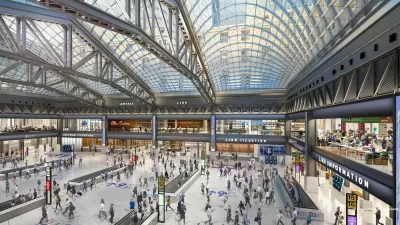Last month N.Y. Gov. Andrew Cuomo proposed that Empire Station replace Penn Station, but many challenging parts, e.g., the Hudson River Tunnels, moving Madison Square Garden, could derail it. A related piece delves into the prior ARC tunnel project.
Proposal #6 in N.Y. Gov. Cuomo's ambitious "multibillion-dollar wish list," what some have dubbed his Robert Moses moment, is "Empire Station." Among the most formidable challenges necessary for the $3 billion modernization of the 1968 rail station, and certainly what may take the longest, is building the the new tunnel under the Hudson River for Amtrak and New Jersey Transit trains.
“It all starts with the tunnels,” Tom Wright, president of the Regional Plan Association, told FoxBusiness.com. More on the Amtrak Gateway project below.
Among the other challenges described by Marissa Piazzola, editor/reporter for Fox Business News, are:
- (E)stablish a rail connection from Penn Station to LaGuardia Airport as well as add a connection to Metro-North, which currently operates out of Grand Central Station [sic].
- (R)edevelopment of the James A. Farley Post Office, which sits across 8th Avenue from Penn, into Moynihan Station. It will increase Penn Station’s size by 50 percent and be connected to Penn by an underground pedestrian concourse.
- Perhaps the most divisive issue surrounding the redevelopment of Penn Station is Madison Square Garden located atop Penn Station between 7th and 8th avenues from 31st to 33rd streets.
See New York Times architectural critic, Michael Kimmelman's most recent piece on this topic, "How to Transform Penn Station: Move the Garden." He's been hammering the same message since at least 2012 if not earlier.
Most surprising in Piazzola's piece was learning that "(t)he Penn Station that we know today was praised as a first class train station upon completion in 1968, five years after the original was demolished."
Of course, ridership on the three rail lines utilizing the station, Long Island Rail Road, New Jersey Transit, and Amtrak, as well as the Seventh and Eighth Ave. subway lines has grown to the point that a "station designed to accommodate 200,000 daily commuters serves more than 650,000 each day," according to Piazzola.
How Will it be Paid for?
"The project will cost $3 billion and be funded by a public-private partnership," writes Piazzola. "Government sources will pay for $325 million of the Empire Station Complex, while the rest will be covered by private investment."
The state issued a 65-page Request for Proposals ([PDF], which outlines its plans for the site in great detail. Developers must submit proposals for either Penn, Farley, or both by April 22.
Access to the Region's Core becomes Amtrak Gateway
The most pressing issue for New Jersey commuters as well as Amtrak passengers using Penn Station going to/from New Jersey is the aforementioned tunnel construction. "Construction of a third train tunnel under the Hudson River was slated for completion by 2018," writes Dunstan Prial in a highly recommended piece that recaps the history of what was an essential project in 2010, and now is an urgent one.
But New Jersey Gov. Chris Christie killed the $12.4 billion ARC project in the fall of 2010 under the premise that New Jersey taxpayers were shouldering too much of the financial burden.
Now the massive infrastructure project is back on the drawing board but the projected cost has risen to more than $20 billion and the new tunnels won’t be completed for another decade and a half, perhaps longer.
“We will have lost 13 years or so as a result of [Gov. Christie's] decision that led to the cancellation of the ARC project,” said Martin E. Robins, a leading architect of New Jersey’s rail transit system over the past 25 years and the chief designer of the ARC tunnel.
Prial goes into the sordid details of how Christie "divert(ed) billions of dollars in ARC money to help bail out the state’s troubled finances without having to raise the state’s 14.50-cent gasoline tax," second lowest [PDF] in the nation after Alaska.
Former U.S. Senator Frank Lautenberg (D-N.J.) called it “one of the biggest policy blunders in New Jersey history.”
Hat tip to Peter Flieg.
FULL STORY: Host of Factors Threaten to Derail Plans for a New Penn Station

Maui's Vacation Rental Debate Turns Ugly
Verbal attacks, misinformation campaigns and fistfights plague a high-stakes debate to convert thousands of vacation rentals into long-term housing.

Planetizen Federal Action Tracker
A weekly monitor of how Trump’s orders and actions are impacting planners and planning in America.

In Urban Planning, AI Prompting Could be the New Design Thinking
Creativity has long been key to great urban design. What if we see AI as our new creative partner?

Milwaukee Launches Vision Zero Plan
Seven years after the city signed its Complete Streets Policy, the city is doubling down on its efforts to eliminate traffic deaths.

Portland Raises Parking Fees to Pay for Street Maintenance
The city is struggling to bridge a massive budget gap at the Bureau of Transportation, which largely depleted its reserves during the Civd-19 pandemic.

Spokane Mayor Introduces Housing Reforms Package
Mayor Lisa Brown’s proposals include deferring or waiving some development fees to encourage more affordable housing development.
Urban Design for Planners 1: Software Tools
This six-course series explores essential urban design concepts using open source software and equips planners with the tools they need to participate fully in the urban design process.
Planning for Universal Design
Learn the tools for implementing Universal Design in planning regulations.
Gallatin County Department of Planning & Community Development
Heyer Gruel & Associates PA
JM Goldson LLC
City of Camden Redevelopment Agency
City of Astoria
Transportation Research & Education Center (TREC) at Portland State University
Jefferson Parish Government
Camden Redevelopment Agency
City of Claremont



























